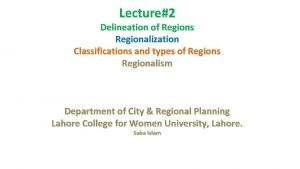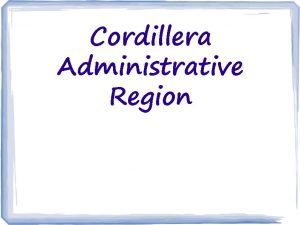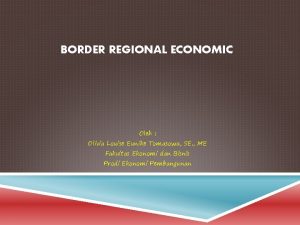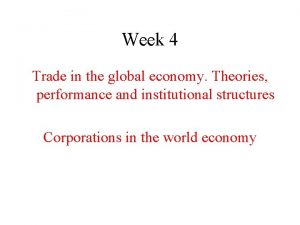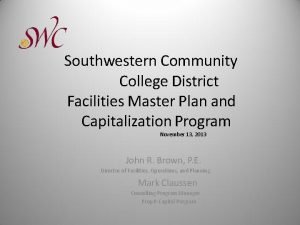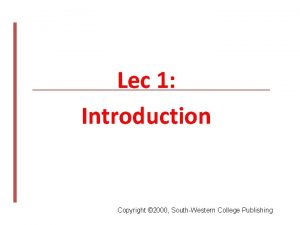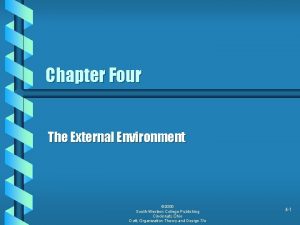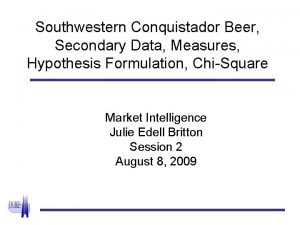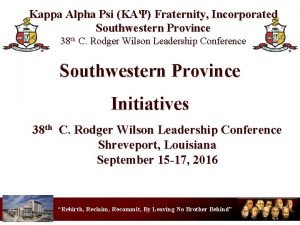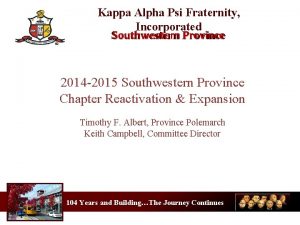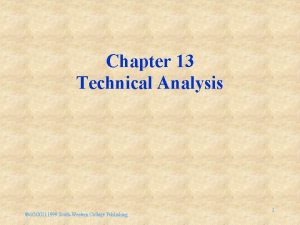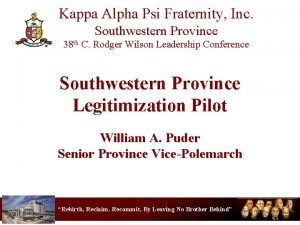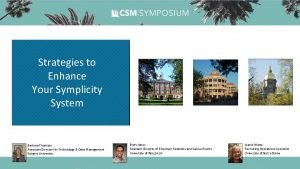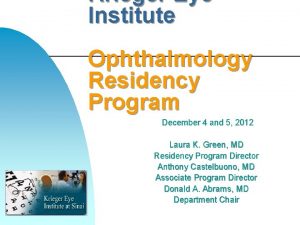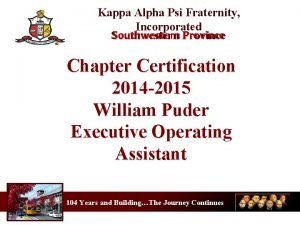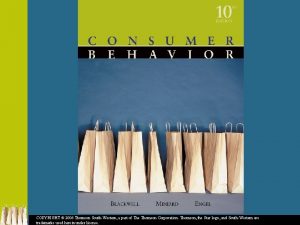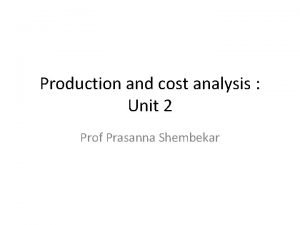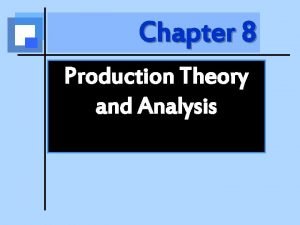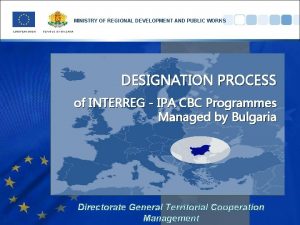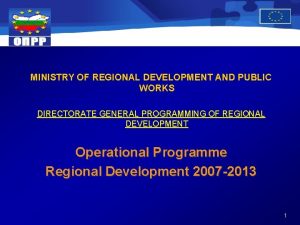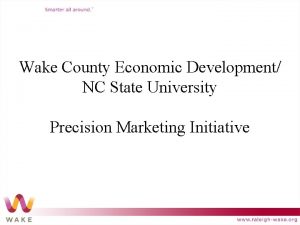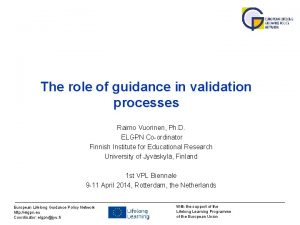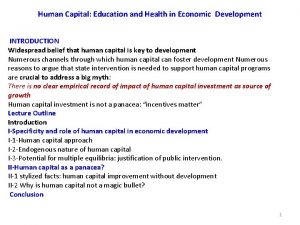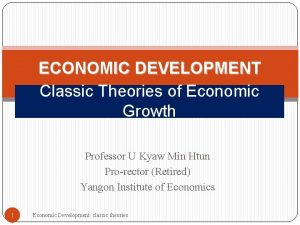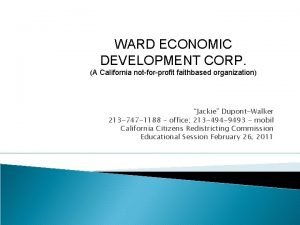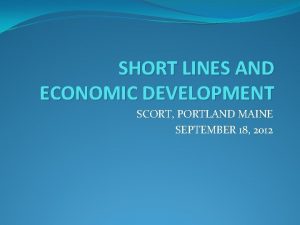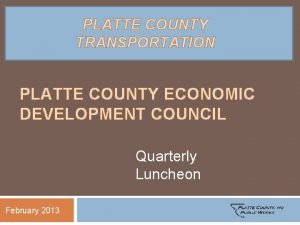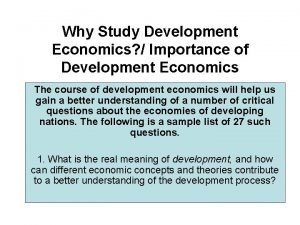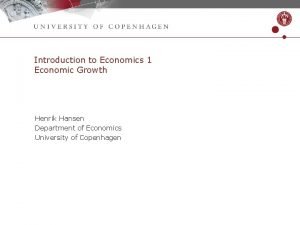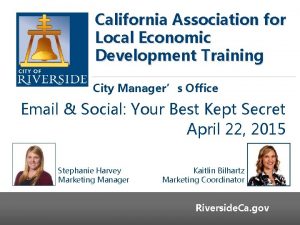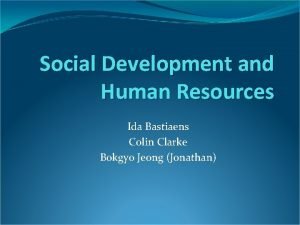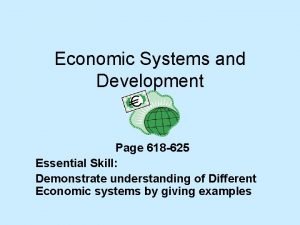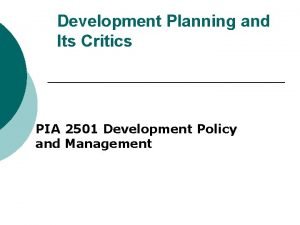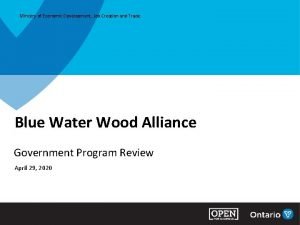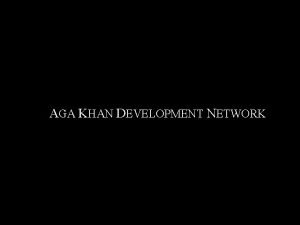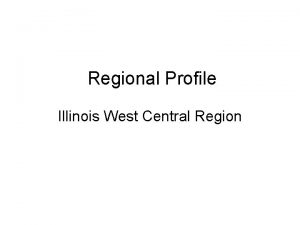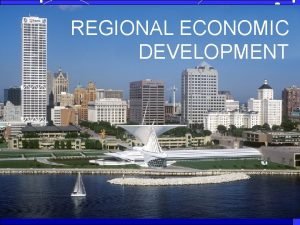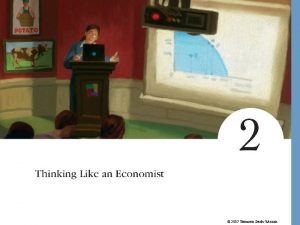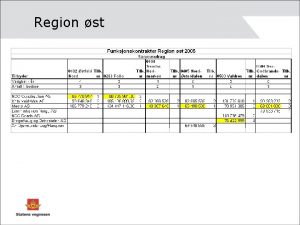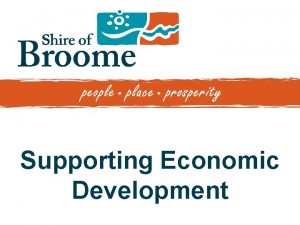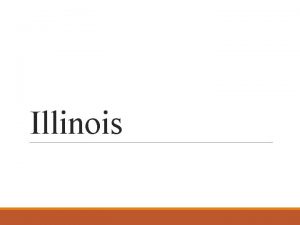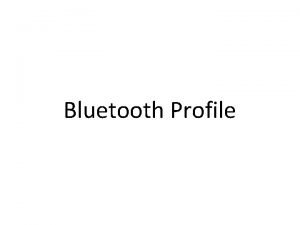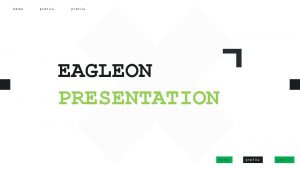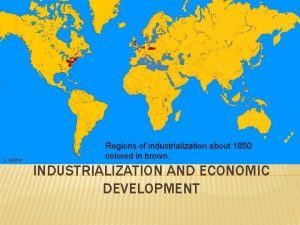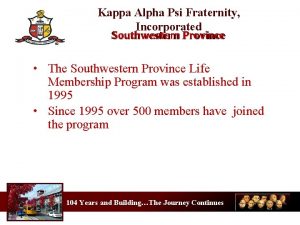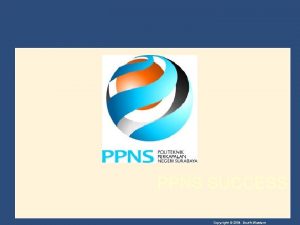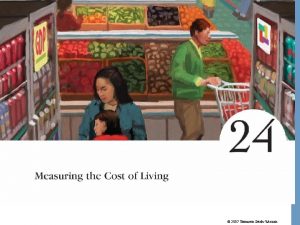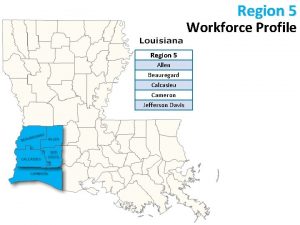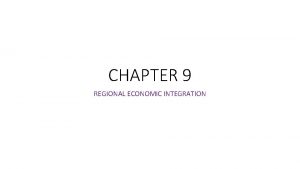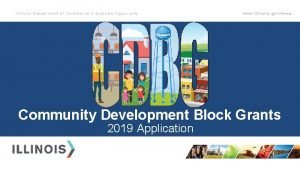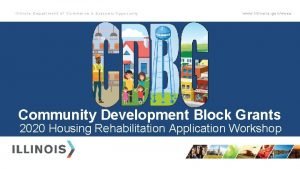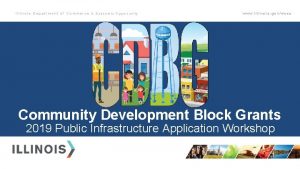Regional Profile Illinois Southwestern Region Illinois Economic Development





























































- Slides: 61

Regional Profile Illinois Southwestern Region

Illinois Economic Development Regions Northern Stateline Northeast Northwest North Central West Central East Central Southeastern Southwestern Southern

Population Projections—Percent Change, 2000 -25 93. 3 85. 8 -3. 3 Source: U. S. Census Bureau

Population Projections by Region and Age, 2005 -25 656, 431 Source: Illinois Department of Commerce and Economic Opportunity

Projected Change in Illinois Population by Age and Race/Ethnicity, 2006 -25 (in Thousands) 659, 702 Source: Illinois Department of Commerce and Economic Opportunity

Projected Change in Illinois Population By Age and Race/Ethnicity, 2005 -25 (Southwestern) 40, 812 Source: Illinois Department of Commerce and Economic Opportunity

Minorities as a Percent of the Total Population, 2006 (Public Use Microdata Areas) Source: 2006 ACS Public Use Microdata Sample

Percent African-American, 2006 (Public Use Microdata Areas) Source: 2006 ACS Public Use Microdata Sample

Percent Hispanic/Latino, 2006 (Public Use Microdata Areas) Source: 2006 ACS Public Use Microdata Sample

Percent Educational Attainment of Population Age 25 -64 By Race/Ethnicity—Illinois, 2005 Source: U. S. Census Bureau, 2005 ACS (PUMS)

Difference in High School Attainment Between Whites and Minorities, * 2006 Vermont * Minorities include African-American, Hispanic, and Native American Source: U. S. Census Bureau, 2006 ACS (PUMS)

Difference in College Attainment Between Whites and Minorities, * 2006 Vermont * Minorities include African-American, Hispanic, and Native American Source: U. S. Census Bureau, 2006 ACS (PUMS)

Percent of Adults with No High School Diploma by Age and Race/Ethnicity, 2006 Source: U. S. Census Bureau, 2006 ACS (PUMS)

Percent of 18 to 24 Year Olds with No High School Diploma, 2006 (Public Use Microdata Areas) Source: 2006 ACS Public Use Microdata Sample

Percent of 25 to 64 Year Olds with No High School Diploma, 2006 (Public Use Microdata Areas) Source: 2006 ACS Public Use Microdata Sample

Percent of 25 to 64 Year Olds with an Associates Degree or Higher, 2006 (Public Use Microdata Areas) Source: 2006 ACS Public Use Microdata Sample

Percent of 25 to 64 Year Olds with a Bachelors Degree or Higher, 2006 (Public Use Microdata Areas) Source: 2006 ACS Public Use Microdata Sample

Per Capita Personal Income as a Percent of U. S. Average—Illinois, 1960 -2005 U. S. Average Source: Regional Economic Information System, Bureau of Economic Analysis, U. S. Dept. of Commerce

Median Earnings of Population Age 25 -64 by Level of Education, 2005 Source: U. S. Census Bureau, ACS

Personal Income per Capita, 2006 (Public Use Microdata Areas) Source: 2006 ACS Public Use Microdata Sample

Percent of Total Population at or Below Poverty Level, 2006 (Public Use Microdata Areas) Source: 2006 ACS Public Use Microdata Sample

Percent Employment in Management and Professional Occupations, 2006 (Public Use Microdata Areas) Source: 2006 ACS Public Use Microdata Sample

Difference in Median Earnings Between a High School Diploma and Associates Degree, 2006 (Public Use Microdata Areas) Source: 2006 ACS Public Use Microdata Sample

Difference in Median Earnings Between a High School Diploma and a Bachelor’s Degree, 2006 (Public Use Microdata Areas) Source: 2006 ACS Public Use Microdata Sample

Student Pipeline, 2004 Of 100 9 th Graders, How Many… Source: NCES Common Core Data 2004; Tom Mortenson, Postsecondary Education Opportunity; NCES, IPEDS Fall 2004 Retention Rate File and Fall 2003 Enrollments, 2004 Graduation Rates; U. S. Census Bureau, 2005 ACS

High School Graduation Rates – Percentage of 9 th Graders Graduating Four Years Later Region (Average 2005 and 2006) Source: IL State Board of Education; NCES, Common Core Data

College-Going Rates—First-Time Freshmen Directly Out of High School as a Percent of Recent High School Graduates, 2004 Source: Tom Mortenson, Postsecondary Opportunity (2004 data update 02 -06 -07)

Illinois Net Migration of College Students by Sector, Fall 2006 Public 4 -Year Private 4 -Year For Profit Private 4 -Year Non-Profit Public 2 -Year Private 2 -Year For Profit Private 2 -Year Non-Profit Public Less than 2 -Year Private Less than 2 -Year For Profit Private Less than 2 -Year Non-Profit Total Source: NCES, IPEDS Residency and Migration Survey

Top Out-of-State Institutions Illinois Residents Attend, Fall 2006 Institution University of Iowa Indiana University-Bloomington Purdue University-Main Campus Marquette University of Wisconsin-Madison University of Missouri-Columbia Carthage College Saint Louis University-Main Campus University of Phoenix-Online Campus Iowa State University Miami University-Oxford Saint Ambrose University Colorado Technical University Online St Louis College of Pharmacy Michigan State University of Notre Dame Kaplan University of Michigan-Ann Arbor Valparaiso University Arizona State University/Tempe Campus University of Colorado at Boulder Northern Michigan University of Kansas Main Campus Western International University Ranken Technical College Washington University in St Louis University of Dayton Butler University Southeast Missouri State University of Wisconsin-Platteville Loras College Drake University Murray State University Grand Valley State University Carroll College Purdue University-Calumet Campus Truman State University State IA IN IN WI WI MO AZ IA OH IA CO MO MI IN IA MI IN AZ CO MI KS AZ MO MO OH IN MO WI IA IA KY MI WI IN MO Source: NCES, IPEDS Residency and Migration Survey First-Time Freshmen 1, 362 994 828 635 514 422 387 363 361 323 292 260 256 230 221 219 207 205 201 200 199 192 187 186 174 158 157 152 149 147 146 137 135 130 FT Freshmen Just Out of High School 1, 360 979 812 630 510 385 384 358 29 316 323 289 4 102 246 230 29 207 205 201 199 195 199 27 124 187 186 173 156 155 152 149 141 146 137 114 130 Sector Description Public 4 -year Private 4 -year Non Profit Public 4 -year Private 4 -year Non Profit Private 4 -year For Profit Private 4 -year Non Profit Public 4 -year Private 4 -year Non Profit Private 4 -year For Profit Public 4 -year Private 4 -year Non Profit Public 4 -year Private 4 -year For Profit Private 4 -year Non Profit Public 4 -year Private 4 -year Non Profit Public 4 -year

Illinois Net Migration of Residents Age 22 -64 by Level of Education, 2004 -05 Less than High School Some College Associate Bachelor's Graduate/Professional Total Source: 2005 ACS (PUMS)

Net Migration by Degree Level and Age Group—Illinois, 1995 -2000 22 - to 29 -Year-Olds 30 - to 64 -Year-Olds Less than High School Some College Associate Bachelor’s Graduate/Professional Total Source: U. S. Census Bureau, 2000 Census; 5% PUMS Files

In-State College-Going Rates Directly Out of High School by Region; Average 2005 and 2006 (Public Institutions Only) Sources: IL State Board of Education, IL Shared Enrollment and Graduation Information

First-Time Undergraduate Enrollment by Region and Sector, Fall 2006 (Percent) Source: NCES, IPEDS Fall Enrollment Survey

Percent of First-Time Freshmen Directly Out of High School Enrolling In-Region; Average 2005 and 2006 (Public Institutions Only) Source: Illinois Shared Enrollment and Graduation Information

Regional Postsecondary Participation of First-Time Students Directly Out of High School (Students from the Southwestern Region in Public Institutions) 1, 797 Source: Illinois Shared Enrollment and Graduation Information

Regional Postsecondary Participation of First-Time Students Ages 25 and Older (Students from the Southwestern Region in Public Institutions) 2, 000 Source: Illinois Shared Enrollment and Graduation Information

Percent in Postsecondary First-Time Enrollment Patterns by Region of Residence; Average 2006 and 2007 (Public Institutions only) REGION OF ENROLLMENT REGION OF Northern East North West RESIDENCE Northeast Stateline. Northwest. Central. Southeastern. Southern Southwestern Northeast Northern Stateline Northwest East Central North Central West Central Southeastern Southern Southwestern 73 9 7 1 2 3 2 0 0 1 99 3 1 0 0 0 0 75 0 0 0 0 0 97 0 0 0 0 0 69 0 0 0 0 0 96 0 0 0 0 Directly Out of High School 13 0 7 3 7 0 5 3 9 0 6 7 86 0 8 1 11 68 7 5 9 0 81 3 7 1 3 84 5 0 1 0 2 0 0 0 7 0 3 1 0 0 0 99 0 0 0 Source: Illinois Shared Enrollment and Graduation Information Age 25 and Older 0 0 0 0 98 0 0 99 0 0 0 0 0 2 0 0 0 99 0 0 0 0 0 89 0 0 3 2 3 5 7 4 4 5 97 8 0 0 0 0 0 79 0 0 0 0 100 0 0 100 2 0 0 1 0 0 98

Distribution of Enrollment at Illinois Community Colleges, Fall 2006 Source: Illinois Board of Higher Education

Transfer Rates by Region (Percent) Fall 2001 Entering CC Cohort with No Prior College Experience Who Completed 12 or More Semester Credits and Transferred to Senior Institutions By Fall 2005 (FY 2007) Source: ICCB Fall Enrollment (E 1), Annual Enrollment and Completion (A 1), Illinois Shared Enrollment and Graduation Data, and National Student Clearinghouse; National Transfer Assembly/UCLA/Cohen Methodology; Rock Valley prior year data used in detail

Enrollment in State-Administered ABE Programs Per 1, 000 Adults Age 18 -64 with Less than a High School Diploma, 2005 Source: U. S. Department of Education; U. S. Census Bureau, ACS

GEDs Awarded per 1, 000 Adults Age 25 -44 with Less than a High School Diploma, 2005 Source: GED Testing Service; U. S. Census Bureau, ACS

Percent of Total Gross State Product by Industry and Comparison to U. S. Source: Bureau of Labor Statistics

Percent of Civilians Age 25 -64 Not Participating in the Workforce—By Education Attainment, 2005 U. S. Illinois Less than High School 37. 0 35. 3 High School 24. 7 24. 1 Some College 21. 0 20. 0 Associate Degree 17. 4 14. 6 Bachelor’s Degree 16. 5 15. 7 Graduate/Prof. Degree 13. 9 12. 5 Source: U. S. Census Bureau, 2005 ACS (PUMS)

Change in Gross State Product, 1997 -2004 Source: Bureau of Economic Analysis

Percent Employment in Management and Professional Occupations, 2006 (Public Use Microdata Areas) 36. 7 28. 9 24. 0 11. 1 Source: 2006 ACS (PUMS) to to 58. 4 36. 7 28. 9 24. 0

Total Occupations with the Most Average Annual Openings Southwestern Region

Demand vs. Supply in Selected Occupations—Gap Between Projected Annual Openings 2004 -14 and Annual Degrees Produced 2005 -06 Nursing Secondary & Vocational Education Computer Engineering Special Education Computer Systems Medical Lab Technology Industrial Engineering Mechanical Engineering Technology More Supply than Demand More Demand than Supply Civil Engineering Technology Chemical Engineering Civil Engineering Mechanical Engineering Electrical Engineering Medical Radiology Technicians Industrial Engineering Technology Electrical Engineering Technology Accounting & Financial Management Elementary Education Administration Source: Occupational Supply and Demand System (data from Illinois Dept. of Commerce and Economic Opportunity and NCES IPEDS Completions Survey)

Innovation Assets

Development Report Card for the States—Illinois C Performance A Business Vitality B Development Capacity Employment Earnings and Job Quality Equity Quality of Life Resource Efficiency F C C D B Competitiveness/Existing Businesses Entrepreneurial Energy A C Human Resources Financial Resources Infrastructure Resources Amenity Resources and Natural Capital Innovation Assets C A A C C STRENGTHS (Top 10 Rank) Rank 2 3 4 5 5 6 7 8 8 10 Measure Initial Public Offerings Change in Homeownership Rate Change in Energy Costs Bridge Deficiency Industrial Diversity Urban Mass Transit Electronic Public Services Disparity between Rural and Urban Areas Vehicle Miles Traveled Strength of Traded Sector Average Annual Pay Average Teacher Salary WEAKNESSES (Bottom 10 Rank) Rank 41 41 43 43 44 44 47 48 48 48 49 Measure Sewage Treatment Needs Renewable Energy Change in Average Annual Pay Unemployment Rate Average Annual Pay Growth Change in New Companies Change in Income from Dividends, Interest and Rent New Companies Employment Growth: Long Term Net Migration Change in Poverty Rate Change in Health Professional Shortage Areas Mass Layoffs Source: 2006 Development Report Card for the States, Corporation for Enterprise Development (CFED)

Illinois Rank—Federal Research and Development Expenditures, 2005 $1, 122, 675 $351, 922 $664, 954 $112, 294 $115, 629 $137, 938 Source: National Science Foundation; U. S. Census Bureau Population Estimates

Gross License Income Per Worker, 2004 46. 5 Source: Development Report Card for the States, CFED

Number of Patents Issued Per $1, 000 Gross State Product 45. 8 Source: 2004/2005 Economic Vision 2010 Report Card, Indiana Chamber

The Fiscal Environment

State Tax Capacity and Effort—Illinois Indexed to U. S. Average U. S. Average Source: State Higher Education Executive Officers (SHEEO)

Projected State and Local Budget Surplus (Gap) as a Percent of Revenues, 2013 Alabama Louisiana Mississippi Tennessee Nevada Texas Oregon Washington Missouri South Dakota South Carolina Idaho Florida North Carolina Indiana Iowa California New Mexico Utah Montana United States Rhode Island Alaska Pennsylvania Illinois Hawaii Georgia New York Arizona Michigan Kentucky West Virginia Colorado Minnesota Oklahoma Nebraska Virginia Arkansas Kansas Connecticut North Dakota Ohio Vermont Wisconsin Massachusetts Maryland Maine New Jersey Delaware New Hampshire Source: NCHEMS; Don Boyd (Rockefeller Institute of Government), 2005

State and Family Share of Funding for Public Higher Education, 1991 -2006 Source: SHEEO State Higher Education Finance Survey

Percent of Income (Average of All Income Groups) Needed to Pay for College Expenses Minus Financial Aid— Public Four-Year Colleges Source: NCPPHE, Measuring Up: The State-by-State Report Card for Higher Education

Percent of Income (Average of All Income Groups) Needed to Pay for College Expenses Minus Financial Aid— Public Two-Year Colleges Source: NCPPHE, Measuring Up: The State-by-State Report Card for Higher Education

Share of Income that Poorest Families Need to Pay for Tuition at Lowest-Priced Colleges Source: NCPPHE, Measuring Up: The State-by-State Report Card for Higher Education

Average Loan Amount Students Borrow Each Year, 2004 Source: NCPPHE, Measuring Up: The State-by-State Report Card for Higher Education

PUBLIC AGENDA FOR ILLINOIS HIGHER EDUCATION Goals for College and Career Success 1. Increase Educational Attainment to match the best-performing U. S. states and most-educated countries. a) Improve success of students; eliminate racial, ethnic and gender Achievement Gaps. b) Increase the number of adults re-entering education and completing a postsecondary credential. c) Reduce Geographic Disparities in educational attainment. 2. 3. Ensure College Affordability for students, families, and taxpayers. Increase Production of Postsecondary Credentials to meet the demands of the economy. a) Increase production of certificates, associate, and baccalaureate degrees. b) Improve transitions between associate and baccalaureate degree levels. c) Increase production of postsecondary degrees in fields critical to the Illinois economy, e. g. nursing and information technology. d) Improve student learning and skill levels to compete effectively in the global marketplace. 4. Better integrate Illinois’ educational, research and innovation assets to meet the economic needs of the state and its regions.
 Economic growth vs economic development
Economic growth vs economic development Economic development vs economic growth
Economic development vs economic growth Characteristics of planning
Characteristics of planning Dangdang ay history
Dangdang ay history Border regional economic adalah
Border regional economic adalah Regional economic integration
Regional economic integration Southwestern community college
Southwestern community college Southwestern college publishing
Southwestern college publishing Southwestern province kappa alpha psi
Southwestern province kappa alpha psi Southwestern college publishing
Southwestern college publishing Southwestern college cincinnati ohio
Southwestern college cincinnati ohio Conquistador beer
Conquistador beer Province of texas
Province of texas Swp kappa alpha psi
Swp kappa alpha psi Kappa alpha psi southwestern province
Kappa alpha psi southwestern province Century 21 southwestern accounting
Century 21 southwestern accounting South western college publishing
South western college publishing Southwestern province
Southwestern province Symplicity rutgers law
Symplicity rutgers law Krieger eye institute residency
Krieger eye institute residency Catherine carpenter southwestern
Catherine carpenter southwestern Kappa alpha psi southwestern province
Kappa alpha psi southwestern province Thomson southwestern
Thomson southwestern Triangular space contents
Triangular space contents Ece
Ece Economic region of production diagram
Economic region of production diagram Economic region of production diagram
Economic region of production diagram Mrtsl
Mrtsl The law of diminishing marginal rate of substitution
The law of diminishing marginal rate of substitution Economic systems lesson 2 our economic choices
Economic systems lesson 2 our economic choices Headwaters regional development commission
Headwaters regional development commission Ministry of regional development and public works
Ministry of regional development and public works Ministry of regional development and public works
Ministry of regional development and public works Entrepreneurship and regional development
Entrepreneurship and regional development Wake county economic development
Wake county economic development Economic social development
Economic social development Northern waterfront economic development initiative
Northern waterfront economic development initiative Human capital education and health in economic development
Human capital education and health in economic development Economic social development
Economic social development Classic theories of economic development: four approaches
Classic theories of economic development: four approaches Primate city frq
Primate city frq Canadian community economic development network
Canadian community economic development network Ward economic development corporation
Ward economic development corporation Scort portland
Scort portland Platte county economic development
Platte county economic development Heather candler
Heather candler Vietnam socio-economic development strategy for 2021-30
Vietnam socio-economic development strategy for 2021-30 Why study development economics
Why study development economics Obstacles to economic development
Obstacles to economic development Georgia academy for economic development
Georgia academy for economic development Economic growth and development
Economic growth and development California association for local economic development
California association for local economic development Ida bastiaens
Ida bastiaens Defination of economic development
Defination of economic development Role of government in economic development
Role of government in economic development Role of state in economic development slideshare
Role of state in economic development slideshare Opportunities in the sahara desert
Opportunities in the sahara desert Marine stewardship council
Marine stewardship council Coop swot
Coop swot Ministry of economic development job creation and trade
Ministry of economic development job creation and trade Downers grove economic development
Downers grove economic development Aga khan fund for economic development sa
Aga khan fund for economic development sa


